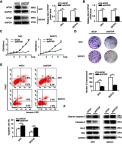WTAP is a prognostic marker of high-grade serous ovarian cancer and regulates the progression of ovarian cancer cells
- PMID: 31496724
- PMCID: PMC6689666
- DOI: 10.2147/OTT.S205730
WTAP is a prognostic marker of high-grade serous ovarian cancer and regulates the progression of ovarian cancer cells
Abstract
Background: The Wilms' tumor suppressor WT1 is reported to work in a range of physiological processes at both transcriptional and posttranscriptional level. WT1-associating protein (WTAP), a nuclear protein co-localized with splicing factors, also plays a vital role in cellular function and cancer progression. However, little is known about the role of WTAP in ovarian cancer and the underlying mechanism.
Materials and methods: To evaluate the expression of WTAP, multiple means were applied in clinical tissues, including immunohistochemistry, quantitative reverse transcriptase PCR (qRT-PCR), and Western blot. Two representative ovarian cancer cell lines (3AO and SKOV3) were used to assess the malignant influence of WTAP on proliferation, apoptosis, and migration. To explore its function, WTAP was additionally down-regulated by lentivirus.
Results: High expression of WTAP in high-grade serous ovarian carcinoma (HGSOC) predicted a shorter overall survival (P<0.01). Furthermore, WTAP expression was higher in HGSOC, compared with that in normal ovary group (P<0.01), benign ovarian tumor group (P<0.01), and non-HGSOC group (P<0.05). In HGSOC, high expression of WTAP was significantly related with the lymph node metastasis (P<0.05). In ovarian cancer cell lines, cell proliferation and migration were considerably reduced after WTAP was down-regulated, while apoptotic rate was increased. Moreover, the effect of WTAP in 3AO and SKOV3 might be relevant with MAPK and AKT signaling pathways.
Conclusion: WTAP is highly expressed in HGSOC, and indicates a worse survival outcome. Therefore, it is highly possible that WTAP has a prognostic implication in the patients of HGSOC. In addition, WTAP down-regulation also plays a tumor suppressor role in 3AO and SKOV3 cell lines.
Keywords: WTAP; diagnosis; ovarian cancer; tumor suppression.
Conflict of interest statement
The authors report no conflicts of interest in this work.
Figures





Similar articles
-
Vascular biology and the sex of flies: regulation of vascular smooth muscle cell proliferation by wilms' tumor 1-associating protein.Trends Cardiovasc Med. 2007 Oct;17(7):230-4. doi: 10.1016/j.tcm.2007.08.002. Trends Cardiovasc Med. 2007. PMID: 17936204 Review.
-
Biological and prognostic value of ETV5 in high-grade serous ovarian cancer.J Ovarian Res. 2021 Nov 4;14(1):149. doi: 10.1186/s13048-021-00899-6. J Ovarian Res. 2021. PMID: 34736492 Free PMC article.
-
Wilms' tumor 1-associating protein promotes renal cell carcinoma proliferation by regulating CDK2 mRNA stability.J Exp Clin Cancer Res. 2018 Feb 27;37(1):40. doi: 10.1186/s13046-018-0706-6. J Exp Clin Cancer Res. 2018. PMID: 29482572 Free PMC article.
-
Uncovering key regulatory pathways and prognostic biomarkers in the tumor microenvironment of high-grade serous ovarian cancer through single-cell RNA sequencing and experimental validation.Front Oncol. 2025 May 9;15:1591430. doi: 10.3389/fonc.2025.1591430. eCollection 2025. Front Oncol. 2025. PMID: 40416874 Free PMC article.
-
High expression of ENPP1 in high-grade serous ovarian carcinoma predicts poor prognosis and as a molecular therapy target.PLoS One. 2021 Feb 26;16(2):e0245733. doi: 10.1371/journal.pone.0245733. eCollection 2021. PLoS One. 2021. PMID: 33635867 Free PMC article.
Cited by
-
N6-Methyladenosine methylation modification in breast cancer: current insights.J Transl Med. 2024 Oct 28;22(1):971. doi: 10.1186/s12967-024-05771-x. J Transl Med. 2024. PMID: 39468547 Free PMC article. Review.
-
Gene Signatures and Prognostic Values of m6A RNA Methylation Regulators in Ovarian Cancer.Cancer Control. 2020 Jan-Dec;27(1):1073274820960460. doi: 10.1177/1073274820960460. Cancer Control. 2020. PMID: 32951457 Free PMC article.
-
Prognostic values of m6A RNA methylation regulators in differentiated Thyroid Carcinoma.J Cancer. 2020 Jul 6;11(17):5187-5197. doi: 10.7150/jca.41193. eCollection 2020. J Cancer. 2020. PMID: 32742465 Free PMC article.
-
Age-related copy number variations and expression levels of F-box protein FBXL20 predict ovarian cancer prognosis.Transl Oncol. 2020 Dec;13(12):100863. doi: 10.1016/j.tranon.2020.100863. Epub 2020 Sep 5. Transl Oncol. 2020. PMID: 32898767 Free PMC article.
-
Role of TNF-α-induced m6A RNA methylation in diseases: a comprehensive review.Front Cell Dev Biol. 2023 Jul 24;11:1166308. doi: 10.3389/fcell.2023.1166308. eCollection 2023. Front Cell Dev Biol. 2023. PMID: 37554306 Free PMC article. Review.
References
LinkOut - more resources
Full Text Sources

